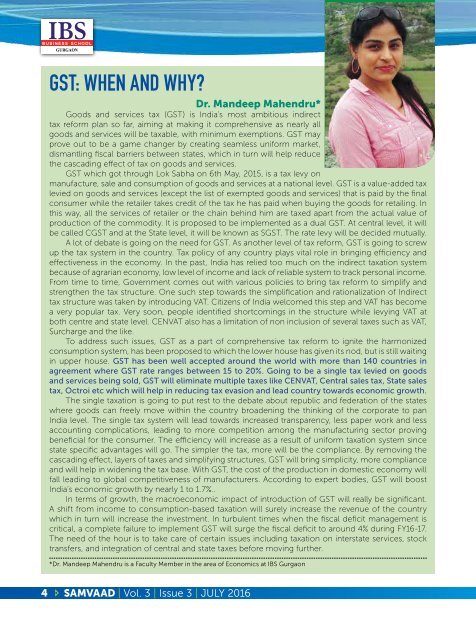Vol 3 | Issue 3 | July 2016
fDPDQxH
fDPDQxH
Create successful ePaper yourself
Turn your PDF publications into a flip-book with our unique Google optimized e-Paper software.
GST: WHEN AND WHY?<br />
Dr. Mandeep Mahendru*<br />
Goods and services tax (GST) is India’s most ambitious indirect<br />
tax reform plan so far, aiming at making it comprehensive as nearly all<br />
goods and services will be taxable, with minimum exemptions. GST may<br />
prove out to be a game changer by creating seamless uniform market,<br />
dismantling fiscal barriers between states, which in turn will help reduce<br />
the cascading effect of tax on goods and services.<br />
GST which got through Lok Sabha on 6th May, 2015, is a tax levy on<br />
manufacture, sale and consumption of goods and services at a national level. GST is a value-added tax<br />
levied on goods and services (except the list of exempted goods and services) that is paid by the final<br />
consumer while the retailer takes credit of the tax he has paid when buying the goods for retailing. In<br />
this way, all the services of retailer or the chain behind him are taxed apart from the actual value of<br />
production of the commodity. It is proposed to be implemented as a dual GST. At central level, it will<br />
be called CGST and at the State level, it will be known as SGST. The rate levy will be decided mutually.<br />
A lot of debate is going on the need for GST. As another level of tax reform, GST is going to screw<br />
up the tax system in the country. Tax policy of any country plays vital role in bringing efficiency and<br />
effectiveness in the economy. In the past, India has relied too much on the indirect taxation system<br />
because of agrarian economy, low level of income and lack of reliable system to track personal income.<br />
From time to time, Government comes out with various policies to bring tax reform to simplify and<br />
strengthen the tax structure. One such step towards the simplification and rationalization of Indirect<br />
tax structure was taken by introducing VAT. Citizens of India welcomed this step and VAT has become<br />
a very popular tax. Very soon, people identified shortcomings in the structure while levying VAT at<br />
both centre and state level. CENVAT also has a limitation of non inclusion of several taxes such as VAT,<br />
Surcharge and the like.<br />
To address such issues, GST as a part of comprehensive tax reform to ignite the harmonized<br />
consumption system, has been proposed to which the lower house has given its nod, but is still waiting<br />
in upper house. GST has been well accepted around the world with more than 140 countries in<br />
agreement where GST rate ranges between 15 to 20%. Going to be a single tax levied on goods<br />
and services being sold, GST will eliminate multiple taxes like CENVAT, Central sales tax, State sales<br />
tax, Octroi etc which will help in reducing tax evasion and lead country towards economic growth.<br />
The single taxation is going to put rest to the debate about republic and federation of the states<br />
where goods can freely move within the country broadening the thinking of the corporate to pan<br />
India level. The single tax system will lead towards increased transparency, less paper work and less<br />
accounting complications, leading to more competition among the manufacturing sector proving<br />
beneficial for the consumer. The efficiency will increase as a result of uniform taxation system since<br />
state specific advantages will go. The simpler the tax, more will be the compliance. By removing the<br />
cascading effect, layers of taxes and simplifying structures, GST will bring simplicity, more compliance<br />
and will help in widening the tax base. With GST, the cost of the production in domestic economy will<br />
fall leading to global competitiveness of manufacturers. According to expert bodies, GST will boost<br />
India’s economic growth by nearly 1 to 1.7%..<br />
In terms of growth, the macroeconomic impact of introduction of GST will really be significant.<br />
A shift from income to consumption-based taxation will surely increase the revenue of the country<br />
which in turn will increase the investment. In turbulent times when the fiscal deficit management is<br />
critical, a complete failure to implement GST will surge the fiscal deficit to around 4% during FY16-17.<br />
The need of the hour is to take care of certain issues including taxation on interstate services, stock<br />
transfers, and integration of central and state taxes before moving further.<br />
*Dr. Mandeep Mahendru is a Faculty Member in the area of Economics at IBS Gurgaon<br />
4 SAMVAAD | <strong>Vol</strong>. 3 | <strong>Issue</strong> 3 | JULY <strong>2016</strong>


